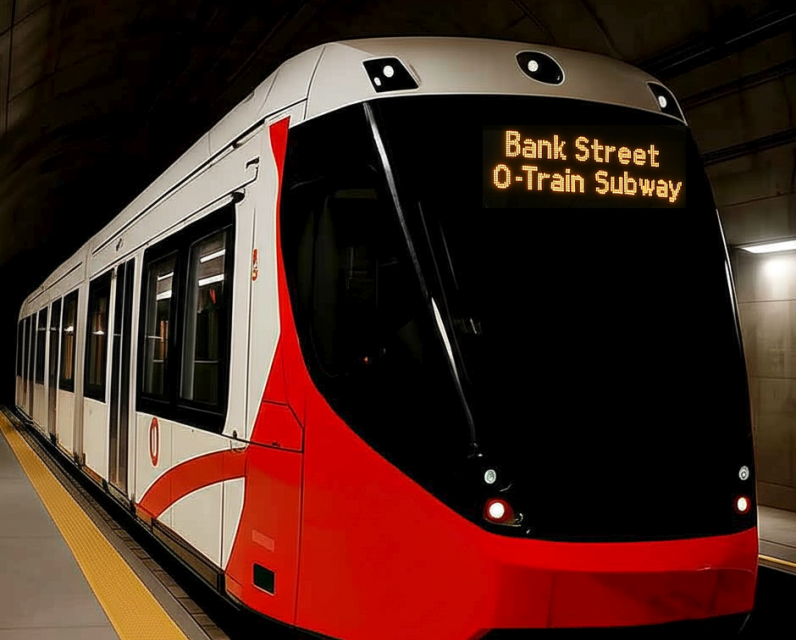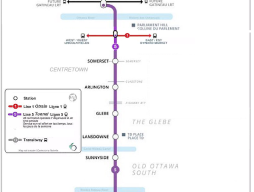Unpublished Opinions
Clinton is an accredited writer for numerous publications in Canada and a panelist for talk radio across Canada and the United States
Ottawa’s Transit Crisis: The Subway That Could Save a City

"Ottawa-Gatineau stands at that same crossroads. It has two choices. Keep making excuses - or build the transit system that will define its future."
Ottawa-Gatineau is growing fast, but its transit system is failing even faster. That the capital city of a G7 nation lags embarrassingly behind in transit while cities worldwide invest in subways - refusing to address the dire state of its main north-south transportation spine - is, frankly, becoming a widely shared joke around the world.
This failure to act isn’t just incompetence - it’s a staggering inability to read the room by Mayor Sutcliffe, an astonishing disconnect from a city on the brink of transportation gridlock and disaster.
The region’s population hit 1,660,269 as of March 31, 2025, and is projected to reach 1.8 million by 2030, ten years ahead of city plans.
Suburbs like Kanata, Barrhaven, and Orleans are growing at four times the national rate, while Gatineau’s west end surges, fueled by rapid expansion in Aylmer and Plateau. Meanwhile, Ottawa’s core is thriving, with thousands heading downtown for events like the Ottawa Senators’ planned LeBreton Flats Arena, Redblacks’ sellout games at TD Place, and Atlético Ottawa’s rising soccer attendance. At the same time, Bank Street communities from Centretown to the Glebe are transforming, with high-rise towers multiplying and density skyrocketing.
Yet, despite this urban boom, suburbanites and Gatineau commuters are stranded by a transit system that refuses to address the elephant in the room - the missing Bank Street O-Train Subway. A north-south subway from Billings Bridge Shopping Centre to Parliament Hill and onwards to Portage & Terrasses de la Chaudière in Gatineau could anchor the core and unify the region, yet no action has been taken. Ottawa’s transit system - once the backbone of its economy - has become a chokehold, strangling business growth, suffocating investment, and cutting people off from job opportunities. Employers struggle to attract talent when commutes are unbearable, and businesses see fewer customers as congestion worsens. Instead of fueling economic momentum, Ottawa’s broken transit network is actively hindering the city’s ability to thrive.
Montreal & Toronto Saw the Warning Signs - Ottawa Didn’t
When Montreal and Toronto reached 1.66 million people, they built subways to handle congestion and fuel growth. Ottawa-Gatineau is at that same population threshold today, yet no Bank Street Subway exists.
Montreal’s Metro at 1.66 Million
By the 1950s, Montreal had a vision for its Metro, prioritizing a core spine beneath Saint Catherine Street to serve dense neighborhoods. It opened in 1966, transforming urban mobility.
Toronto’s Subway at 1.66 Million
Toronto’s metro hit 1.66 million in the early 1950s, and by 1954, the Yonge Subway opened, carving a transit backbone that connected suburban commuters with downtown jobs.
Ottawa’s failure to prioritize a Bank Street subway, despite parallel population and event-driven demand, showcases a lack of vision.
A City Stranded by Transit Failures
Ottawa’s transit overhaul in April 2025 slashed 120+ routes, forcing commuters into 60-90-minute transit nightmares. Bank Street, the city’s primary urban spine, is gridlocked, with 6 and 7 buses delayed 40 percent of the time. Gatineau’s STO buses clog Ottawa’s streets, yet no O-Train link exists. A Bank Street Subway would unify the region, serving sports fans, Gatineau workers, and new downtown residents, but its absence leaves the suburbs and Gatineau disconnected.
Sports and Density Boom, But Transit Lags
Ottawa’s sports and real estate surge keeps intensifying. The LeBreton Flats Arena, targeted for 2028, will draw thousands. The Redblacks’ TD Place opener on June 13, 2025, against the Montreal Alouettes is trending toward a sellout. Atlético Ottawa’s crowds keep rising, after 14,992 fans attended the 2022 CPL Final. Bank Street’s development explosion continues, with towers like 900 Bank in the Glebe and new Old Ottawa South projects adding thousands of residents.
Yet, suburban commuters from Barrhaven, Orleans, and Gatineau struggle with torturous commutes, and bridge traffic is a permanent bottleneck. Without a north-south Bank Street Subway, Ottawa-Gatineau’s growing core remains cut off from the people who need it most.
Ottawa-Gatineau’s Path Forward
Ottawa-Gatineau’s worsening transit crisis mirrors what forced Montreal and Toronto to act. A Bank Street Subway - running from Billings Bridge Shopping Centre to Parliament Hill and onwards to Portage & Terrasses de la Chaudière in Gatineau - could be a game-changer, linking sports, residents, and businesses. With Confederation Line 1 handling east-west travel, and Trillium Line 2, the Carleton University and Airport line, a Bank Street subway would let Ottawa’s transit finally function, slashing commute times, cutting emissions, and fueling business growth from Parliament Hill to Old Ottawa South.
No More Delays. No More Excuses. Ottawa-Gatineau Must Act.
Every growing city faces a choice. Invest in transit and move forward - or ignore the problem and fall behind. Montreal and Toronto made the right decision decades ago, and their economies, mobility, and livability soared. Now, Ottawa-Gatineau stands at that same crossroads.
Mayor Sutcliffe’s inability to “read the room” is costing residents time, money, and mobility. The city has two choices. Keep making excuses - or build the transit system that will define its future.




Comments
Be the first to comment